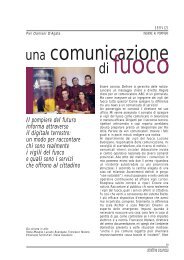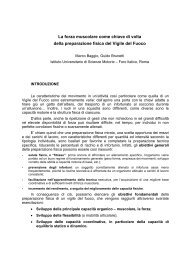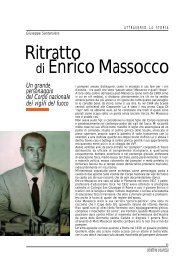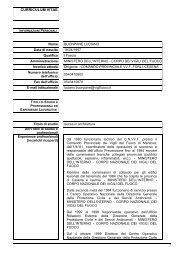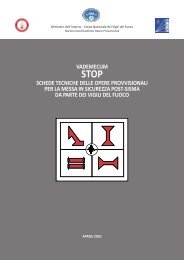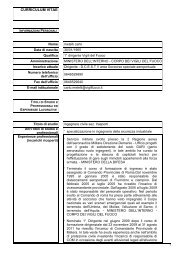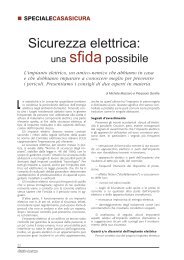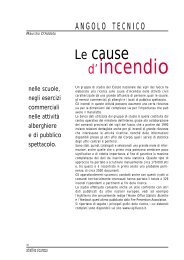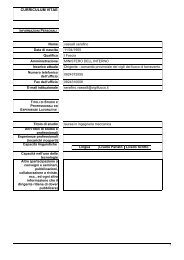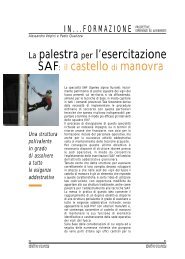Il comportamento umano negli incendi - gruppo di ricerca in ...
Il comportamento umano negli incendi - gruppo di ricerca in ...
Il comportamento umano negli incendi - gruppo di ricerca in ...
Create successful ePaper yourself
Turn your PDF publications into a flip-book with our unique Google optimized e-Paper software.
<strong>Il</strong> <strong>comportamento</strong><strong>umano</strong> <strong>negli</strong> <strong><strong>in</strong>cen<strong>di</strong></strong>I N . . . F O R M A Z I O N ELe scienzedel <strong>comportamento</strong>al serviziodella sicurezzaUn caso per tutti è quello del matematico <strong>in</strong>glese Ed Galea, <strong>di</strong>rettoredel <strong>gruppo</strong> <strong>in</strong>gegneristico sulla “fire safety” all’università <strong>di</strong> Greenwich<strong>in</strong> UK che ha sviluppato un modello <strong>di</strong> simulazione al computer <strong>di</strong>propagazione ed evacuazione; lui sostiene che la comprensionedelle tipiche azioni umani e delle reazioni emotive, cognitive e<strong>in</strong>terpersonali sia fondamentale. A questo proposto ha chiamato alavorare nel suo <strong>gruppo</strong> numerosi scienziati del <strong>comportamento</strong> eadesso sta svolgendo un stu<strong>di</strong>o sulla risposta alle sireneant<strong><strong>in</strong>cen<strong>di</strong></strong>o tramite due esperimenti <strong>in</strong> Inghilterra e <strong>in</strong>Brasile che prevedono l’analisi delle videoriprese <strong>di</strong>persone <strong>in</strong> una biblioteca. L’associazione <strong>in</strong>ternazionaleche si occupa <strong>di</strong> questi temi l’<strong>in</strong>ternational associationof fire safety science <strong>negli</strong> ultimi anni organizza simposie conferenze specificatamente sul “<strong>comportamento</strong><strong>umano</strong> <strong>negli</strong> <strong><strong>in</strong>cen<strong>di</strong></strong>”.In conclusione, le persone reagiscono <strong>di</strong> fronte ad un pericolocome il fuoco <strong>in</strong> modo <strong>di</strong>verso ma ci sono caratteristiche personalie con<strong>di</strong>zioni socio-ambientali che <strong>in</strong>coraggiano o scoraggianodeterm<strong>in</strong>ate sequenze comportamentali. La conoscenza del “fattore<strong>umano</strong>” <strong>in</strong> queste circostanze può aiutare a migliorare l’azione <strong>di</strong>soccorso dei vigili <strong>di</strong> fuoco e garantire la sicurezza <strong>di</strong> tutti.BibliografiaMileti, D. S. e Peek L. (2005) “The social construction of safety: consider<strong>in</strong>gthe importance of communicat<strong>in</strong>g risk <strong>in</strong>formation”.Earthquake Disasters, a cura <strong>di</strong> E. Rovai and C. M. Rodrigue. New York:Routledge.Sime J.D. (1985) “Movement towards the familiar: person and place affiliation<strong>in</strong> a fire entrapment sett<strong>in</strong>g”. Environment and Behavior, 17, 697-724.Mawson A.R. (2005). “Understan<strong>di</strong>ng mass panic and other collective responseto threat and <strong>di</strong>saster”. Psychiatry, <strong>in</strong>terpersonal and biological processes, 68,95-113.Proulx, G. (2005). “Analysis of Published Accounts of the World Trade CenterEvacuation”. Federal Buil<strong>di</strong>ng and Fire Safety Investigation of the World TradeCenter Disaster.57obiettivo sicurezza



